|
|
Updated as per The Known Sphingidae of Costa Rica, November 2007
Updated as per More, Kitching and Cocucci's Hawkmoths of Argentina 2005, December 2009
Updated as per
AN ANNOTATED CHECKLIST OF THE SPHINGIDAE OF BOLIVIA, December 2009
Updated as per Sphingidae (Lepidoptera) de Venezuela, Compilado por: María Esperanza Chacín; December 2009
Updated as per CATE (Mexico, Belize, Guatemala, Venezuela, Ecuador, Peru, Bolivia, Argentina, Brazil, Paraguay); February 6, 2011
Updated as per personal communication with Greg Nielsen (Villavicencio, Meta, Colombia, January 10, 2011, 500m); February 6, 2011
Updated as per French Guiana Systematics: Sphingidae; May 13, 2011
Updated as per personal communication with Sergio D. Ríos Díaz in CATÁLOGO DE LOS SPHINGIDAE (INSECTA: LEPIDOPTERA) DEPOSITADOS EN
EL MUSEO NACIONAL DE HISTORIA NATURAL DEL PARAGUAY; sent to me in July 2014 by Sergio D. Ríos Díaz.
Updated as per personal communication with Joanna Rodriguez Ramirez (Chaco; Argentina), January 21, 2015
Updated as per personal communication with Ezequiel Bustos (Shilap revta. lepid. 43 (172) diciembre, 2015, 615-631 eISSN 2340-4078 ISSN 0300-5267), January 4, 2016
|
Erinnyis crameri
(Schaus, 1898)
Cramer's Sphinx Moth
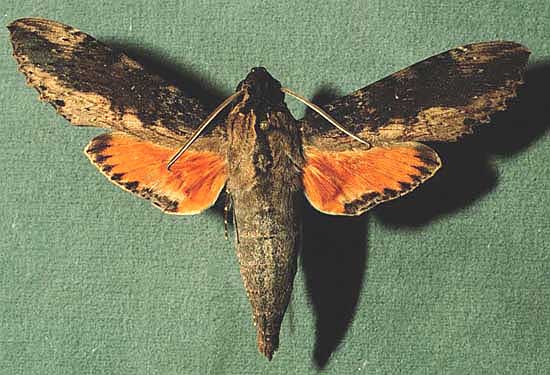
Erinnyis crameri male courtesy of Dan Janzen.
This site has been created by
Bill Oehlke at oehlkew@islandtelecom.com
Comments, suggestions and/or additional information are welcomed by Bill.
TAXONOMY:
Family: Sphingidae, Latreille, 1802
Subfamily: Macroglossinae, Harris, 1839
Tribe: Dilophonotini, Burmeister, 1878
Genus: Erinnyis Hubner, [1819] ...........
Species: crameri Schaus
1898
|
MIDI MUSIC
.....It's a Wonderful World.....
copyright C. Odenkirk
ON.OFF
<bgsound src="world.mid" LOOP=FOREVER>
|
DISTRIBUTION:
Cramer's sphinx, Erinnyis crameri
(Wing span: 3 1/4 - 3 3/4 inches (approximations: males: 79-85mm; females: 85-98mm)),
flies in tropical and subtropical lowlands and foothills
from Bolivia and Paraguay north through Central America,
Mexico;
Belize: Cayo;
Guatemala;
Costa Rica;
and the West Indies. It probalby flies throughout Central Americ. This species strays north to southern
Florida (specimen type locality), southern Texas, Arizona, and southern California.
In South America it has been taken from
Colombia: Meta: Villavicentio (GN);
Venezuela: Aragua, Barinas; as far south as
Bolivia: Santa Cruz (450m);
French Guiana: Saul; Piste Crique
Ecuador;
Peru;
Bolivia;
Brazil;
Argentina: Corrientes, Entre Rios, Formosa, La Rioja, Misiones, Chaco (JRR), Tucuman and
Paraguay: Asuncion, Concepcion, Amambay.
I fully anticipate it also flies in Guyana and Suriname.
I suspect it also flies in Uruguay, but it has not be confirmed from that nation.
The upperside of the abdomen is gray, without black bands, and the underside does not have black spots.
The upperside of the forewing is dark brown (may fade considerably), and it may have pale yellow-brown patches at the tip and along the
inner edge. The upperside of the hindwing is dull orange with a narrow black border.
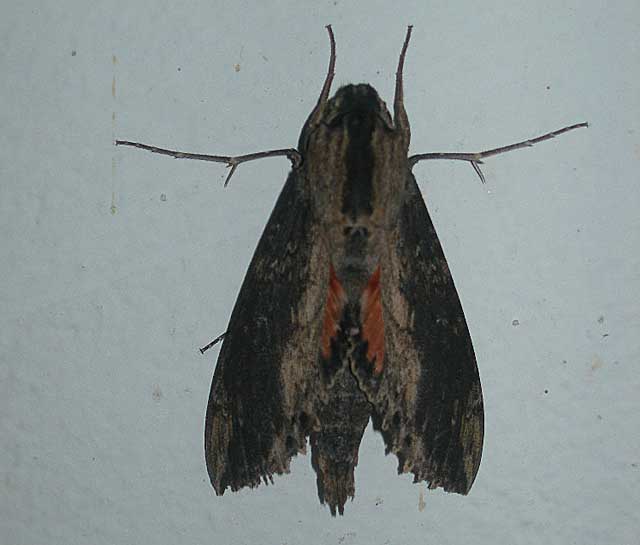
Erinnyis crameri, Itanhandu, Minas Gerais, Brazil,
July 25, 2012, courtesy of Larry Valentine.
Erinnyis crameri is similar to Erinnyis oenotrus, but crameri has
1) pale tegulae highlighting the dark brown or black median stripe;
2) lacks black dots on the underside of abdomen;
3) has a pale area on the forewing, along the entire inner margin; and
4) has the dark marginal band of the hindwing upperside broken into a series of clearly defined, diamond/triangular-shaped spots on the ends of the veins. CATE
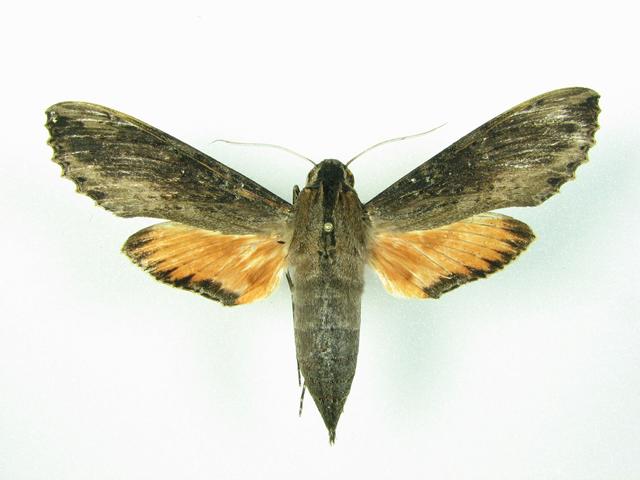
Erinnyis crameri, Villavicencio, Km 13 via Acacias, Meta, Colombia, lfw=42mm,
04°03’55.0 N 073°41’87.0 W, January 10, 2011, 500m, courtesy of Gregory Nielsen.
FLIGHT TIMES:
Erinnyis crameri broods continuously in the tropics and in south Florida.
Specimens have been taken in French Guiana in February, but it probably also flies in other months. Gregory Nielson reports a January flight in Colombia.
Sergio Rios Diaz confirms flights in Paraguay in January, March, July and November in Paraguay.
During the night adults nectar at flowers, including bouncing bet (Saponaria officinalis).
Moths are on the
wing from July-August in the southern United States. In Costa Rica moths have been taken in all months except February and March.
ECLOSION:
Adults eclose from pupae formed in loose cocoons spun among surface litter.
Pupal stage can be as few as fourteen days.
SCENTING AND MATING:
Females call in the males with a pheromone released from a gland at the tip of
the abdomen.
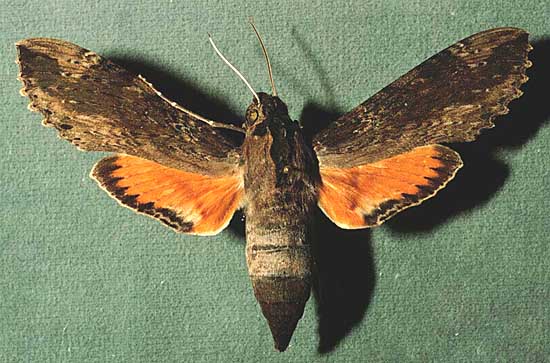
Erinnyis crameri female courtesy of Dan Janzen.
EGGS, LARVAE, PUPAE:
Larvae feed on various plants in the dogbane family (Apocynaceae):
Rauvolfia ligustrina, Rauvolfia tetraphylla, Stemmadenia obovata.
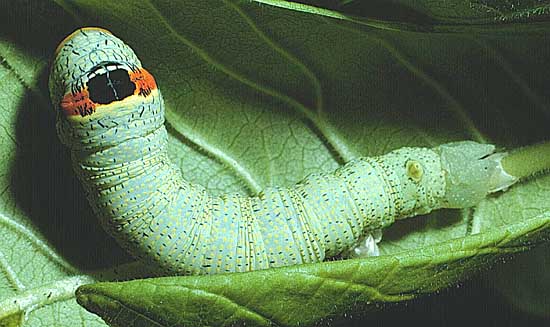
Erinnyis crameri green form courtesy of Dan Janzen.

Erinnyis crameri dark form courtesy of Dan Janzen.
Larvae are subject to parasitization by Drino piceiventris in the Tachinidae family and by
Microplitis figueresi in the Braconidae family.
Return to U. S. A. Table
Return to Sphingidae Index
Return to Dilophonotini Tribe





